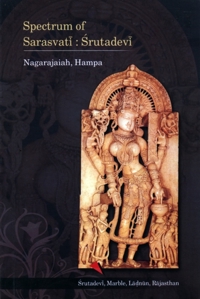So many poets in various Indian languages have sought Sarasvatī's blessings. To illustrate Kannada sources are cited, restricted to mostly Jaina poets. The earliest extant Kannada work, the Kavirājamārga (850 CE), 'The Way of the King of poets', authored by Śrīvijaya, opens with a benedictory verse praising and requesting Sarasvatī to reside in poet's heart: 'the venerable deity who has the vivid-pure color, sweet voice, wise savoury words, eternal goddess...' [Kavirājamārga, 1-3]. Poet Ranna (993 CE) refers to her as vāk [Sāhasa-Bhīma-Vijaya, 1-7]. According to poet Nemicandra (1175 CE) jagake Jinendraruktiye Sarasvatī, 'the word of Lord Jina is Sarasvatī to the Universe' [Neminātha Purāṇam, 1-38]. Mahākavi Pampa (941 CE) states that parama Jinendra-vāṇi, 'the words of supreme Lord Jina', is Sarasvati [Ādipurāna, 1-9J. Keśiraja (1235 CE), the greatest Kannada grammarian, commences his work, the Śabda-maṇi-darpaṇa, 'Jewel-mirror-of (Kannada) Grammar', with eulogy to Vāgdevi, reflecting his esteem for goddess of speech.
Nemicandra (1175 CE), one of the major Kannada poets mentioned above, refers to Sarasvatī as surabhi (Kāmadhenu), 'the celestial cow', and milk ooze out from her breast. He desires that she will affectionately milch him with mastery over language [Neminātha Purāṇam, 1-22]. In another verse poet Nemicandra describes 'Sarasvatī merrily revels in the lotus pond of my poetry' (ibid 1-36). Famous Grammarian Keśirāja, mentioned in the above paragraph, employs the epithet Vāgdevī to describe her [Sabdamaṇi-darpaṇa, 1-1].
Another major Kannada poet Bandhuvarma (1160 CE) describes Sarasvatī with the epithets of Kāmakalā-nidhi, Pāda-payodhara-yugme, nāṭya-vidyā-mukhi, rājanīti-padalakṣaṇa-locane, sārahaste, dharmāmrta-vākye and rasa-bhave [Harivaṁśābhyudaya, 1-8].
In the same breath we should remember that poet Paṁpa was not against the popular belief of 'Sarasvatī is goddess of knowledge'. Elsewhere in his Ādipurāṇa, Paṁpa refers to the deity as Vāg-vadhū, deity of speech, and describes himself as Sarasvatī-maṇihāra, 'a string of gems to Sarasvatī'. In his epic the Vikramārjuna-Vijaya olim Paṁpa-Bhārāta, Paṁpa once again refers to the goddess as 'Ambike Sarasvati, 'the mother of all learning', and Sarasvatige posatu māḍuva Paṁpana vāgvilāsamaṁ '(poet) Paṁpa's grace of (poetic) style enhances the glory of Sarasvatī's speech'.
Ranna (993), major poet and a worthy successor of Paṁpa, repeats the idea that the goddess is vāk-sundari, 'beautiful lady of speech', who is adorned with 32 rasas + alaṁkaras (phrases of poetics). As a rare gesture, Ranna ridicules the literati who misuse their literary skill gifted by Sarasvatī. Ranna goes to the extent of naming such authors as Sarasvatī-drohi, 'betrayer of Sarsvatī'. Poet Nayasena (1112 CE), author of the Dharmāmṛta, also refers to her as Vāk-sundari and requests her to stay in his lotus-face, i.e., in his poem. Similar desire and expression gets repeated in many more works of other writers.
 Prof. Dr. Nagarajaiah Hampana
Prof. Dr. Nagarajaiah Hampana
